(Duane Hanson, Fleamarket Lady, 1990 © VG Bild-Kunst, Bonn, 2013, Courtesy of Institute for Cultural Exchange, photo-foto Alan Ginsburg.tif, SABAM Belgium 2014)
The American dream is a cloud fueled by optimism. The cloud might be toxic. It can also be terrific as it drifts from coast to coast, like the cigarette you crave and will ultimately leave you wanting for more. The Duane Hanson retrospective at the Museum van Elsene/Musée d’Ixelles grounds the haze, revealing the dreamers, while leaving the shape of the dream to your imagination.
Duane Hanson (1925-1996) was born just before the Great Depression and first received notoriety in the 1960s, initially praised not for formal or technical achievement, but for the brutal and at times grotesque reality he reproduced to scale. Gangland murders, dead soldiers, addiction, riots, and tense race relations were some of the themes that led to his international acclaim.
Duane Hanson: sculpting American dreams
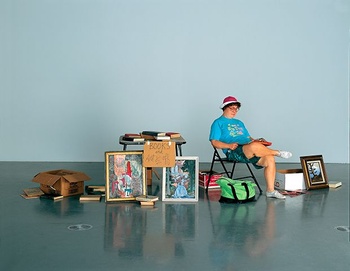
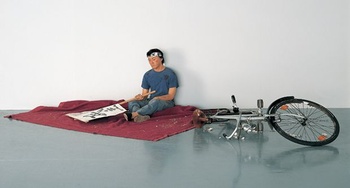
(Duane Hanson, Chinese Student, 1989-1990 © VG Bild-Kunst, Bonn, 2013, Courtesy of Institute for Cultural Exchange, photo Alan Ginsburg, SABAM Belgium 2014)
In 1972, he was invited to documenta, after which he fell momentarily into obscurity, which, along with age and illness, might explain the shift to subtlety in his later work. Hanson is one of many exceptional postwar American artists who forced a national rewriting of what art means, how it’s produced, and for whom. He belongs to a generation of sculptors who broke ranks with tradition. While Dan Flavin played with light and Walter De Maria worked with the land, Hanson remained faithful to realism and the depiction of daily life. In this period, realism had a place in emerging photographic practice as Robert Frank’s Americans answered to Ansel Adams’s Landscapes, and Nan Goldin, Mary Ellen Mark, and others opened doors for the likes of Larry Clark, Zoe Strauss, or Harmony Korine. Post Norman Rockwell and Edward Hopper however, it wasn’t as popular an approach for painting or plastic arts, which is probably why Hanson is remembered as being a pop artist. Pop and a set of soup cans may have legitimized realism, but in his outspoken rejection of romanticism and efforts to eradicate artificial aesthetics, Hanson’s legacy is closer to that of Gustave Courbet’s than it ever was to Warhol’s.
In 1972, he was invited to documenta, after which he fell momentarily into obscurity, which, along with age and illness, might explain the shift to subtlety in his later work. Hanson is one of many exceptional postwar American artists who forced a national rewriting of what art means, how it’s produced, and for whom. He belongs to a generation of sculptors who broke ranks with tradition. While Dan Flavin played with light and Walter De Maria worked with the land, Hanson remained faithful to realism and the depiction of daily life. In this period, realism had a place in emerging photographic practice as Robert Frank’s Americans answered to Ansel Adams’s Landscapes, and Nan Goldin, Mary Ellen Mark, and others opened doors for the likes of Larry Clark, Zoe Strauss, or Harmony Korine. Post Norman Rockwell and Edward Hopper however, it wasn’t as popular an approach for painting or plastic arts, which is probably why Hanson is remembered as being a pop artist. Pop and a set of soup cans may have legitimized realism, but in his outspoken rejection of romanticism and efforts to eradicate artificial aesthetics, Hanson’s legacy is closer to that of Gustave Courbet’s than it ever was to Warhol’s.
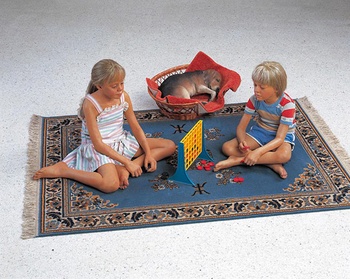
(Duane Hanson, Children Playing Game, 1979 © VG Bild-Kunst, Bonn, 2013, Courtesy of Institute for Cultural Exchange, SABAM Belgium 2014)
Keep it real
28 works are displayed in Brussels, and only Abortion (1965) falls into the earlier, more aggressive category of his catalogue. It walked the line between art and activism as unregulated backroom procedures ended and abortion was eventually legalised in the United States (1973). Here, it is the sole work with direct reference to a national issue. The rest are hyper-realistic portraits of the people national issues affect. They represent slices of suburban life, and citizens who appear important, because they are present and yet lack any particular sign of importance. That is of course, if you don’t find doctors, students, couples, cleaners, or children important. If Hanson’s results are more or less real than the statues at Madame Tussauds, I can’t say until I spend some time with the works. What I can confirm is that I know these people! Not like I know Prince William, JCVD, or any other star set in wax. I don’t know them as entertainment. I know their postures, their clothes, and their unspoken language. I’ve been to their homes, and don’t see this as a show about the banality of “everyday” people, but perhaps on the contrary, one that states there is no such thing as an everyday person; we are all absolutely awesome.
Keep it real
28 works are displayed in Brussels, and only Abortion (1965) falls into the earlier, more aggressive category of his catalogue. It walked the line between art and activism as unregulated backroom procedures ended and abortion was eventually legalised in the United States (1973). Here, it is the sole work with direct reference to a national issue. The rest are hyper-realistic portraits of the people national issues affect. They represent slices of suburban life, and citizens who appear important, because they are present and yet lack any particular sign of importance. That is of course, if you don’t find doctors, students, couples, cleaners, or children important. If Hanson’s results are more or less real than the statues at Madame Tussauds, I can’t say until I spend some time with the works. What I can confirm is that I know these people! Not like I know Prince William, JCVD, or any other star set in wax. I don’t know them as entertainment. I know their postures, their clothes, and their unspoken language. I’ve been to their homes, and don’t see this as a show about the banality of “everyday” people, but perhaps on the contrary, one that states there is no such thing as an everyday person; we are all absolutely awesome.
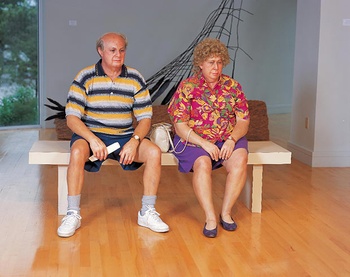
(Duane Hanson, Old Couple on a Bench (edition 1-2), 1994 © VG Bild-Kunst, Bonn, 2013, Courtesy of Institute for Cultural Exchange, photo Roy G. Crogan, SABAM Belgium 2014)
The Minnesota-born, Florida-based sculptor used a direct casting method that has since been employed by artists such as Jeff Koons, Charles Ray, Robert Gober, or more recently Mark Jenkins, and the exhibition details his process through photo documentation and unfinished molds. It’s a big exhibition. I don’t mean the number of works, the biceps of Bodybuilder, or the obesity of Queenie and the Man with Walkman, but in terms of the questions it opens up about art, representation, and the expansive vernacular landscape of the American Dream.
Lost in translation
Hanson recognised his subjects’ lives as works of art, and with fiberglass, clothes, paint, and props made sure that other people saw them in the same way. He doesn’t speculate on their worries or aspirations. Judgment is futile and thus absent, at least until reviews get written. In texts related to this travelling retrospective, the work is described as vilifying consumer society and American mass culture via illusionist works that reveal disturbing truths and present characters who are lonely, desperate, and far from success. I have to wonder where this comes from. How do we know that the Cowboy doesn’t run a tech start-up, that the High School Student wasn’t a valedictorian, or that the Medical Doctor isn’t a leader in his field, with two kids and a loving wife waiting when he returns from the office? Hanson isn’t telling us about their perils, he is just putting these people back into our space and the dignity this preserves, risks being lost in art translation.
The Minnesota-born, Florida-based sculptor used a direct casting method that has since been employed by artists such as Jeff Koons, Charles Ray, Robert Gober, or more recently Mark Jenkins, and the exhibition details his process through photo documentation and unfinished molds. It’s a big exhibition. I don’t mean the number of works, the biceps of Bodybuilder, or the obesity of Queenie and the Man with Walkman, but in terms of the questions it opens up about art, representation, and the expansive vernacular landscape of the American Dream.
Lost in translation
Hanson recognised his subjects’ lives as works of art, and with fiberglass, clothes, paint, and props made sure that other people saw them in the same way. He doesn’t speculate on their worries or aspirations. Judgment is futile and thus absent, at least until reviews get written. In texts related to this travelling retrospective, the work is described as vilifying consumer society and American mass culture via illusionist works that reveal disturbing truths and present characters who are lonely, desperate, and far from success. I have to wonder where this comes from. How do we know that the Cowboy doesn’t run a tech start-up, that the High School Student wasn’t a valedictorian, or that the Medical Doctor isn’t a leader in his field, with two kids and a loving wife waiting when he returns from the office? Hanson isn’t telling us about their perils, he is just putting these people back into our space and the dignity this preserves, risks being lost in art translation.
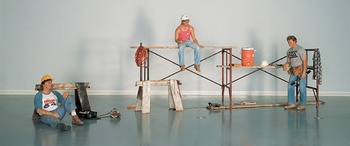
(Duane Hanson, Lunchbreak, 1989 © VG Bild-Kunst, Bonn, 2013, Courtesy of Institute for Cultural Exchange, SABAM Belgium 2014)
It’s condescending and one-sided to talk of a devastated American Dream and sing praise for the respect Hanson paid to so-called “invisible Americans”. He appeared to be fighting, but not for a museum that becomes a human zoo, where homage eventually becomes humiliation. Invisible? Not a chance, and he apparently wanted it to stay that way. These characters are as familiar to me as they were to Hanson, who surely didn’t see his kids as invisible. Two works that didn’t make it to Belgium, Surfer (1987) and Cheerleader (1988), were cast on their teenage bodies. What father sees his children as tragically failed? Do you think his eyes moistened with pity and scorn for their suburban plight or beamed with pride in the face of their glorious potential?
DUANE HANSON: SCULPTURES OF THE AMERICAN DREAM • 20/2 > 25/5, di/ma/Tu > zo/di/Su 9.30 > 17.00, €5/8, Museum van Elsene/Musée d’Ixelles, rue Jean Van Volsemstraat 71, Elsene/Ixelles, 02-515.64.21, www.museumvanelsene.be, www.museedixelles.be
It’s condescending and one-sided to talk of a devastated American Dream and sing praise for the respect Hanson paid to so-called “invisible Americans”. He appeared to be fighting, but not for a museum that becomes a human zoo, where homage eventually becomes humiliation. Invisible? Not a chance, and he apparently wanted it to stay that way. These characters are as familiar to me as they were to Hanson, who surely didn’t see his kids as invisible. Two works that didn’t make it to Belgium, Surfer (1987) and Cheerleader (1988), were cast on their teenage bodies. What father sees his children as tragically failed? Do you think his eyes moistened with pity and scorn for their suburban plight or beamed with pride in the face of their glorious potential?
DUANE HANSON: SCULPTURES OF THE AMERICAN DREAM • 20/2 > 25/5, di/ma/Tu > zo/di/Su 9.30 > 17.00, €5/8, Museum van Elsene/Musée d’Ixelles, rue Jean Van Volsemstraat 71, Elsene/Ixelles, 02-515.64.21, www.museumvanelsene.be, www.museedixelles.be
Read more about: Expo
Fijn dat je wil reageren. Wie reageert, gaat akkoord met onze huisregels. Hoe reageren via Disqus? Een woordje uitleg.